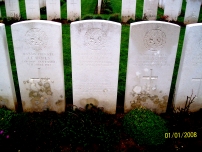| First Name: | Colin Stewart | Last Name: | CALDER | |
|---|---|---|---|---|
| Date of Death: | 09/04/1917 | Lived/Born In: | Wanstead | |
| Rank: | Private | Unit: | London14 | |
| Memorial Site: | 1. Wanstead Memorial 2. Leyton Library | |||
Current Information:Age-22 21, Seagry Road, Wanstead London Cemetery, Neuville-Vitasse, France
The Battle of Arras was a series of offensives by the British Army between 9th April 1917 and 16th May 1917. It had been planned in conjunction with the French who would attack in Artois and between them the Allies would force the Germans out of the large salient they had held since the line of trenches was first established. But the Germans had spoiled this plan by falling back to the new and very strong Hindenburg Line in January 1917 and the salient no longer existed. For the want of an alternative plan the attack went ahead anyway. It all started well for the British who made substantial gains on the first two days but then the offensive ground to a halt and by the end their losses amounted to over 150,000. The First Battle of the Scarpe (9-14 April) 56th (London) Division attacked at 7.45 on the morning of 9th April, 1917 with their objective being the Wancourt-Feuchy trench system, the Brown line. 168 Brigade attacked from Beaurains on the left of the divisional front with 13th London and 12th London in front. The objective of 13th London was the strongly fortified village of Neuville-Vitasse while 12th London, on their left, were charged with capturing 600 yards of the ridge running north from the village, along which ran Pine Lane, a well wired German trench. After some hard fighting these objectives were reached and shortly after midday, 14th London were able to pass through and continue on to attack the Hindenburg Line. Their objective was part of the Hindenburg Line called the Cojeul Switch which was comprised of three trenches; ‘Telegraph Hill’ in front, ‘Card’ in support and ‘Back’ in reserve. It was not an easy task for 14th London. Telegraph Hill Trench was captured after a hard struggle, some moved on to Card Trench and a platoon even made it as far as Back Trench but the left hand company had lost direction and headed off into 14th Division’s area, sweeping through three lines of trenches, capturing 150 prisoners and moving on a further 600 yards across the open. In danger of becoming isolated and cut off they then fell back to the front trench of the Cojeul Switch. Those who had made it as far as Back Trench were unable to retain possession of it and they too fell back to Telegraph Hill Trench which was then consolidated. By the end of the day, 56th Division had advanced some 2000 yards, but not without cost having sustained over 800 casualties. One of these was Colin Calder of 14th London. |
||||
| « Back to Search Results | ||||
| If you think any of the information shown here is incorrect, Click Here to submit your amends and comments | ||||




